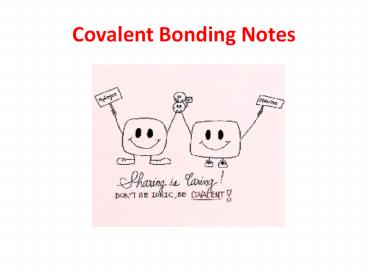Covalent Bonding Notes - PowerPoint PPT Presentation
Title:
Covalent Bonding Notes
Description:
Covalent Bonding Notes Ionic vs Covalent Bonding Ionic: electron(s) leave one atom & gained by another atom to satisfy both atoms octets, this results in the ... – PowerPoint PPT presentation
Number of Views:297
Avg rating:3.0/5.0
Title: Covalent Bonding Notes
1
Covalent Bonding Notes
2
Ionic vs Covalent Bonding
- Ionic electron(s) leave one atom gained by
another atom to satisfy both atoms octets, this
results in the formation of ions. The resulting
opposite charges attract each other. - Covalent electrons are shared by two or more
atoms to satisfy their octets.
3
How can you tell if a bond is IONIC or COVALENT?
- Subtract the two electronegativity values (look
at an electronegativity chart p. 263). - gt1.7 to 4.0 Ionic
- gt0.4 to 1.7 Polar Covalent
- 0.0 to 0.4 Non-Polar
Covalent - Electronegativity atoms ability to attract
electrons in a chemical bond. (higher
electronegativity means the atom wants electrons
more)
4
How can you tell if a bond is IONIC or COVALENT?
- Easy way
- All metals metallic bond
- Nonmetals and Metals ionic bond
- All nonmetals covalent bond
5
Yes, there are 2 kinds of covalent bonds!
- Polar covalent the electrons are shared, but one
atom is pulling on the electrons a lot more. The
electrons spend more time around that atom. - Nonpolar covalent the electrons are evenly
shared between the two atoms.
6
O(3.5) H (2.1) 1.4Polar covalent bond
7
- The closer the elements are on the periodic
table, their electronegativities are more
similar more likely to form covalent bonds - Farther away greater difference in
electronegativity more likely to form ionic
bonds. - Metal nonmetal usually ionic
- Nonmetal nonmetal usually covalent.
8
Properties of Covalent Compounds
- 1) Covalent compounds generally have much lower
melting and boiling points than ionic compounds.
- 2) Covalent compounds are soft and squishy
(compared to ionic compounds, anyway).
9
Properties, Contd
- 3) Covalent compounds tend to be more flammable
than ionic compounds. - There are exceptions to this rule!
- 4) Covalent compounds don't conduct electricity
in water.
10
Bond Dissociation Energy
- Bond dissociation energy energy required to
break a covalent bond. - Highest bond energy
Lowest bond energy - Hardest to break
Easiest to break - Triple Double Single
- Bond Bond Bond
- Shortest bond length
Longest bond length - Strongest Weakest
11
How to Name Covalent Compounds
- 1. Name the first element
- (normal name)
- 2. Name the second element
- (root name -ide)
- 3. Add prefixes to indicate how many atoms of
each element are in the molecule - (Subscripts)
- Exception no need to use mono for first
element. Example CO2 carbon dioxide
12
Prefixes
Subscript prefix
1 Mono
2 Di-
3 Tri-
4 Tetra-
5 Penta-
6 Hexa-
7 Hepta-
8 Octa-
9 Nona-
10 Deca-
13
Memorize these exceptions
Chemical formula name
H2O water
CH4 Methane
NH3 ammonia
14
MEMORIZE THESE ACID NAMES
Acid Name
HCl Hydrochloric acid
H2SO4 Sulfuric acid
15
Diatomics
- Diatomic elements are elements that do not exist
singularly in nature because they are highly
reactive. - Which elements are the diatomics?
- HON, its the halogens!
- H2, O2, N2, F2, Cl2, Br2, I2































